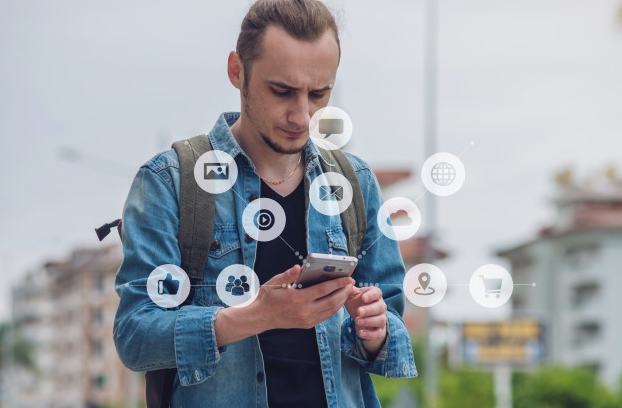Online omnipresence: the new normal [and how to start as an advertiser]
Author: Daisycon (part of Linehub)
Reading time: 7 minutes
Date of publication:
The arrival of the new decade has brought many unprecedented challenges for lots of businesses and entrepreneurs. Besides working from home and limited face-to-face contacts, consumers are discouraged from shopping in physical stores. This is why it is more important than ever to focus on the online environment, to ensure that your brand is top-of-mind with online consumers.
An effective way to achieve this top-of-mind association is to use the right combination of online touchpoints, making your brand visible throughout the entire buying process. In other words: online omnipresence (Zavattaro & Sementelli, 2014).
As a result, potential customers will recognize your brand more easily, which increases their willingness to make a purchase (Meyerson & Scarborough, 2007). In this blog, we’ll discuss how you can ensure that your brand stays top-of-mind with consumers (despite the disappearance of most offline channels): through affiliate marketing.
Online omnipresence and the customer journey
In order to understand online omnipresence, it is important to empathize with the consumer. According to the customer journey funnel theory (Lemon & Verhoef, 2016), every potential consumer embarks on a ‘journey’ before he or she decides to buy something. This journey starts when a consumer becomes aware of their need that can be fulfilled with your product (or service).
“Consumers are looking for products all over the internet, so it’s good to be visible in more places than just your own website” – Andre Heijmans, Intens Wonen (2020)
In the beginning, the consumer will have little knowledge about their desired product. Their interests are rather broad, and many brands seem to qualify as a decent fit. In order to make the best choice, the consumer will obtain information about the different options (Lemon & Verhoef, 2016). He or she can find this information in blogs, magazines, or stores. These places are examples of touchpoints.

The journey
The impact of a touchpoint on a potential customer depends on the customer journey stage he or she is in (Lemon & Verhoef, 2016). Imagine that the consumer decides to go on a round-the-world trip and she comes to the conclusion that she still needs the right equipment for this trip. In order to be able to make the right choice, the consumer will gather information.
Initially, the consumer doesn’t exactly know what kind of equipment she needs and will therefore look for general information about a product, such as a travel bag. This kind of information can be found, for example, on a travel blog. As the consumer becomes more familiar with the product, she will want to obtain more detailed, specific information (Lead Forest, 2019): which bag has the most storage space, and what materials is the bag made of? Comparison websites are the place where she can easily find this information.
After selecting the right material, size, and price category, two options remain. Because this is a tough choice, she decides to postpone it. However, when she stumbles upon a website where she finds a 10% discount code for one of the bags, she is convinced: she proceeds to purchase the travel bag right away, and her journey can begin!

Selecting the right touchpoints
As a marketer, you have to make a lot of choices, including the use of touchpoints. We see that many marketers limit themselves to only a few touchpoints in the customer journey because of budgets.
For example, you can focus on end-funnel marketing by offering voucher codes to returning website visitors, or you can choose to familiarise consumers with your brand earlier in the funnel by bidding on keywords in Google Shopping. In this article, you’ll read more about the best way to partner up with Google CSS partners.
Although both marketing activities are effective, they also have their flaws. While Google Shopping marketing reaches a large group of potential consumers, for many, this marketing does not offer them enough specific information to make an immediate purchase.
At the same time, discount code marketing is an excellent way to convince consumers, but it only targets a tiny part of your potential consumers: people who have already specifically landed on your website (more than) once before.
Create a flow
This is where online omnipresence makes the difference: by spreading your visibility across the entire funnel, you create a “flow” of touchpoints (Lemon & Verhoef, 2016). These connecting touchpoints ensure that the consumer stays in touch with your brand during the entire journey of searching for the right product. As a result, your brand remains top-of-mind for the consumer and you start building a strong association between the needs of the consumer and the brand. In turn, this association will contribute to a higher conversion rate (Meyerson & Scarborough, 2007).
“As a brand, I think it is important that you are always visible.” – Eric Mulder, Green Bubble (2020)
Taking the current circumstances into account, online omnipresence is more important than ever. Since consumers are advised to avoid contact with others, the chances of encountering offline touchpoints, such as shop assistants during a store visit or a bus stop poster, are smaller. The reduction of information flows will cause your brand to no longer be top-of-mind, consequently reducing consumers’ chances of making a purchase. To fill this gap of information, advertisers will have to create more visibility in the online environment.
Online omnipresence & affiliate marketing
The most efficient way to realize omnipresence for your brand is to use an affiliate marketing network. Such platforms offer a wide range of high-quality media, and these are categorized by type (blogs, email parties, promotional code publishers, etc.). Moreover, collaboration, contracting, and communication all take place within one channel and the effectiveness of each media can be compared.
Engagement Mapping
By using engagement mapping, you can accurately track the customer journey of your potential customers that are attracted through affiliate collaborations. This information clarifies in which areas your brand is strongly represented and at the same time pinpoints at what stage improvements can be made. In addition, Daisycon offers you the opportunity to determine which publisher matches your brand best, in an accurate manner.
The performance of each affiliate is clearly displayed in various statistics. For example, you can easily compare the results of last month with that same month in the previous year or filter the results for one type of publisher to see which affiliate performs best within this category. This information enables you to make timely adjustments so you can build the ideal publisher mix for your brand.
Conversion Assist
Engagement mapping isn’t just beneficial for you as an advertiser but can also be of great importance for publishers that own media that are predominantly effective at the beginning of the funnel, including blogs and content sites. These types of media create awareness and interest among potential consumers but generate relatively few conversions. However, creating such interest is necessary to realize conversions later on in the funnel (Lead Forest, 2019).
You could say that these media assist in converting consumers to other websites. This assistance (also called conversion assist) is measured by an affiliate network. This makes it possible to adequately reward early funnel media for their efforts.
Of course, you don’t have to manage the setup, maintenance, and expansion by yourself, because an experienced channel manager will always be there for you to help you out. The results? Gradually developing an affiliate marketing campaign in which your brand is visible throughout the entire funnel. In other words: creating online omnipresence.
Conclusion
When you use the right touchpoints, a flow is created that contributes to your brand’s awareness. In turn, this awareness contributes to a higher probability of potential customers converting. Now that many offline touchpoints are missing, it is more important than ever for you to be visible in the online environment. With the help of an affiliate network like Daisycon, you can achieve this in an effective and efficient manner.
Although we can’t be certain as to when offline touchpoints will be fully operational again, we know one thing for sure: the time to boost your online marketing is now. Whether your brand is part of energy, telecom, fashion, dating, financial services, or something else, the 40.000+ publishers in the Daisycon network offer endless possibilities!
